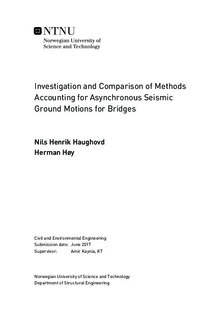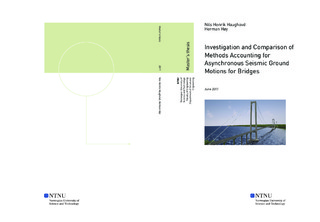| dc.description.abstract | Eurocode 8, part 2, presents various methods to incorporate asynchronous seismic excitation for bridges. Common practice is to use time history analyses due to their high level of accuracy; however, they are computationally expensive. The aim of this study was therefore to investigate whether other, faster, methods could produce comparable results, and to examine their strengths and weaknesses. Two finite element models were developed in ANSYS: 1) the Chacao Bridge, which is a large two-span suspension bridge, and 2) a four-span beam bridge for verification of implementation and results.
The single-point response spectrum method generally proved to be conservative, and results corresponded well with those from the simplified method in the Eurocode. However, the simplified method presented greatly amplified response for the Central Pylon in the Chacao Bridge, and the method's pseudo-static displacements failed to account for varying seismic characteristics.
The multi-point response spectrum method in ANSYS was by far the fastest and most user-friendly method. It provided the most coincident results with those from the time history analysis. However, the results from the two bridge models led to different observations. The response for the four-span beam bridge was overestimated, while the response for the Chacao Bridge was slightly underestimated. The method proved to be sensitive to the structure's configuration and stiffness. Consequently, small, stiff structures and structural components spanning multiple supports may be severely overestimated using this method. On the other hand, accurate results may be obtained for large and soft structures with independently moving components.
Displacements and rotations were successfully extracted from Der Kiureghian and Neuenhofer s response spectrum method. The Eurocode's simplified version provided identical results, and its simplifications were justified. However, forces and moments could not be calculated due to inaccuracies in the transfer function. | |

